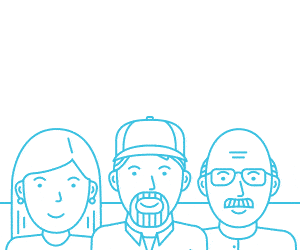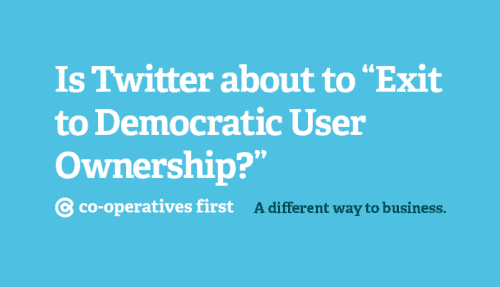Recently, Twitter made headlines with news a group of shareholders are calling for the company to investigate the feasibility of turning the social media giant into a co-operative. The process of a joint stock company changing its legal structure to that of a co-operative is called mutualisation. (Or as it appears in the AGM document: “Exit to Democratic User Ownership.”)
Mutualisation is not a process that occurs frequently. In rare cases, apartments in high-cost housing markets mutualize to increase home ownership through a for-profit co-op model. Likewise, some insurance companies mutualize to better serve their policyholders. But the decision to mutualize is far from being the norm.
So, should Twitter mutualize? Could it even? Short answer is probably not. But let’s look at this a bit closer.
It would be HUGE. The world’s largest co-operative, in fact.
Currently, Twitter has the 12th largest population on earth (319 million), behind the United States of America (321 million), just ahead of Indonesia (256 million). Facebook holds the largest population with 1.6 billion. If the resolution were to pass, this could make Twitter the largest co-operative business in the world, and navigating the transition would be seriously complicated – not landing a person on the moon complicated, but still pretty darn complicated. (Just imagine chairing the AGM!)
At a loggerhead.
The complex logistics and single-focus dedication required to transfer legal designation and replacement of pertinent organizational documents is tremendous during the mutualizing process. For a company the size of Twitter, this process would be a monumental task for the organization’s leadership. Understandably the board and management are a bit miffed by this suggestion, and referred to the proposal as a “misallocation of resources and a distraction to our board of directors and management.”
That said, the shareholders advocating for the proposal provide an interesting and compelling argument – or at least one that sounds okay divorced from having to make the transition a reality:
“A community-owned Twitter could result in new and reliable revenue streams, since we, as users, could buy in as co-owners, with a stake in the platform’s success. Without the short-term pressure of the stock markets, we can realize Twitter’s potential value, which the current business model has struggled to do for many years. We could set more transparent accountable rules for handling abuse. We could re-open the platform’s data to spur innovation. Overall, we’d all be invested in Twitter’s success and sustainability. Such a conversion could also ensure a fairer return for the company’s existing investors than other options.”
According to this argument, transitioning to a co-operative business model would be a way to re-engage users in the platform, offering them an opportunity to actively participate in the organization’s governance. Likewise, a co-operative could better define and enforce membership conditions, criteria and relations, which could have implications for platform abuse and accounts controlled by ‘bots.’
Most Twitter users would probably get behind not receiving bot spam, but perhaps there’s an easier way to solve Twitter’s bot spam and abuse problems than mutualizing.
Strengthening revenue? Possibly.
There is an argument to be made regarding strengthening financials by restructuring as a co-operative – albeit one that radically shifts (and diversifies) revenue sources. Operating as a co-operative would allow ownership of the company to become better regulated and less susceptible to a buy-out or takeover. Further implementing a fee structure with engaged members could structure the platform for stable revenue streams that avoid some of the influence of the stock market.
That said, a fee structure could kill the active user base, and reduce the audience size for the presently more lucrative ad revenue stream. So, tough choices would have to be made, alongside some fairly major experiments, to achieve stable, profitable and desirable revenue streams.
Similar examples? Not really.
The proposal references multiple examples of large co-operative businesses that are stronger because of their structure:
- The Associated Press: a co-op owned by over 1700 newspapers and 5000 radio and TV broadcasters.
- Stocksy United: the stock-photo distributor whose shareholder classes include employees, management and photographers.
- The Green Bay Packers: the only community-owned American professional sports team has a membership of over 360,000 with no single shareholder holding more than 4% of the 5.01 million shares.
In each of these examples the co-operative business model has been used to bring a community (journalists, photographers and football fans respectively) together to advance a common interest (quality news stories, better pay for high quality stock photography and NFL football) and generate revenue. While we greatly appreciate the innovations on the co-operative model represented in these examples, and each has been successful, none of the above examples comes close in terms of member/shareholder numbers (or interests); and, perhaps more importantly, they also didn’t have to try and mutualize first.
If Twitter had started out as a co-operative and was considering a transition to investor-driven revenue strategies and operations, the position might be more favorable. Platform co-operatives with a multi-stakeholder structure are increasing in popularity, and hold potential for tech startups having trouble attracting VC investment initially. Once established, these platform co-op startups could position the business up for future VC involvement and a transition to an investor-driven revenue strategy and business structure. Going the other direction is quite a bit more problematic.
So, how to find the right fit? Do your homework.
As mentioned, Twitter shareholders will most likely not approve this proposal. (And they probably shouldn’t.) But it has sparked an interesting conversation. Ownership is cent
For co-operative businesses, engaging community is important, especially if members of that community are also your primary revenue source. If your user base and revenue source are separate, and the business is struggling to turn a profit, as is the case with Twitter, it could be the business structure needs some tweaking. In some cases, that revised structure should be a co-operative. If your user base is larger than the populations of most countries in the world, and you’ve grown up with VCs and investor-driven revenue strategies, maybe find a simpler solution to saving the business.
Or not. The impact of Twitter becoming a co-operative could spark a revolution in online business structures. Perhaps in a way that is good for everyone.
If you’re thinking about starting a business, and a co-operative is an option, we’re here to help. Contact us.

 Written by
Written by 



